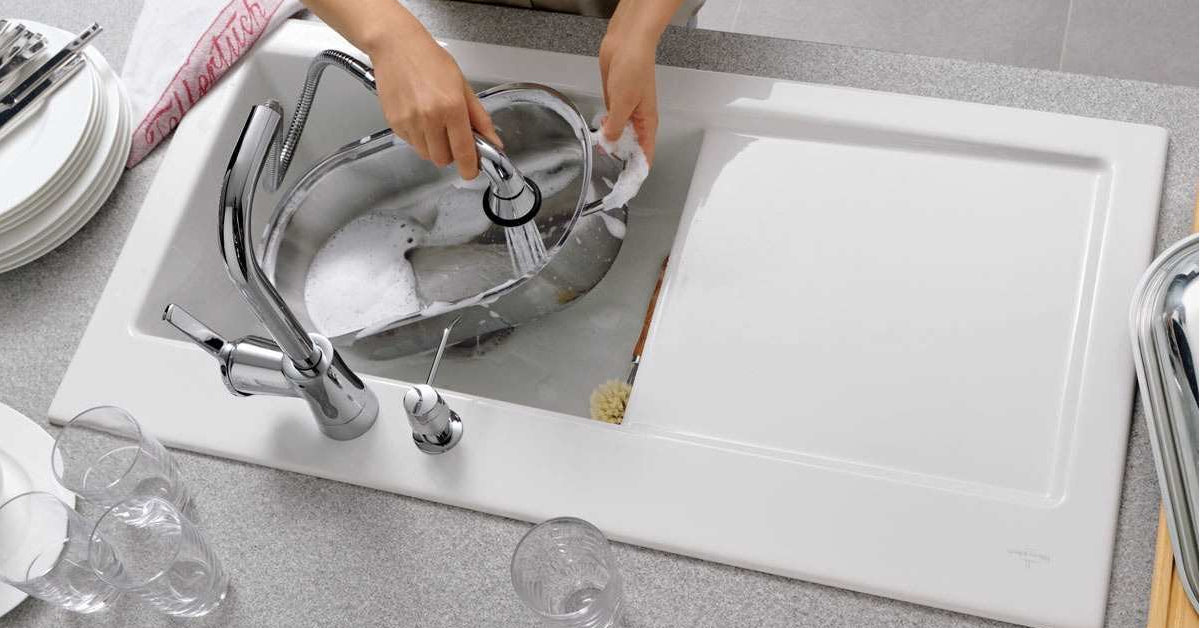
Why Your Kitchen Sink Won’t Hold Water: Common Fixes
|
|
Time to read 5 min
Written by: Taps UK
|
Published on
|
Time to read 5 min
A kitchen sink that won’t hold water properly can quickly become a nuisance. Whether you’re trying to soak dishes, rinse vegetables, or fill the bowl for cleaning, a leaking sink wastes time and makes everyday tasks more difficult. The good news is that in most cases, the problem is minor and easy to fix yourself.
This article looks at the most common reasons why a sink won’t hold water — from worn plugs and faulty seals to issues with the waste fitting — and offers straightforward advice on how to put things right. You’ll also find simple maintenance tips to help prevent the same issue happening again.
This usually happens due to a faulty or ill-fitting sink plug, a worn or damaged rubber seal, or debris preventing the plug from sealing properly.
If water consistently drains even when the plug is in place, the rubber seal may be worn or cracked. Replacing the plug or seal often solves the issue.
Yes. Grease, food particles, or dirt can prevent the plug from sitting flush in the waste outlet. Cleaning the area around the drain can restore the seal.
Not always. Simple fixes like replacing the plug, seal, or cleaning the waste outlet can be done at home. If the waste fitting itself is damaged, professional help may be needed.
It depends on use, but most rubber seals last a few years. If you notice leaks or the plug feels loose, it’s time to replace it.
If your sink is draining slowly after being filled, but you can’t see any leaks underneath, your first thought might be that the basket strainer, waste, plug, or seal is faulty. Many plumbers may even suggest replacing the strainer or plug right away.
However, in most cases, the basket strainer seal or plug isn’t the real cause. In fact, a worn rubber seal accounts for less than 1% of issues.
Instead of rushing to replace parts, it’s best to follow a few simple checks:
Test the rubber seal on the basket strainer for visible wear or damage.
Check if the plug is sitting flush and forming a proper seal.
Inspect the surrounding area for any signs of residue or debris affecting the seal.
By going through these steps, you can confirm if the problem really lies with a faulty seal or plug — or if something else is causing your sink to lose water.
The basket strainer waste—often simply called the sink plug—sits inside a metal flange at the base of your sink. When pressed down, the black rubber seal on the underside of the plug makes contact with the flange to create a watertight seal.
To test if your basket strainer waste is faulty:
Push the basket strainer waste/plug down as normal to engage the seal.
Fill the sink with a small amount of water, just enough to cover the top of the plug.
Important: Do not let the water level rise over the metal sink flange.
Now check what happens:
If the water drains away, the basket strainer plug or rubber seal is faulty and needs replacing. If your sink is still under warranty, you may be able to claim a free replacement. Otherwise, you can buy replacements easily—most are compatible as long as the size is correct.
If the water stays put, your basket strainer waste is working correctly and forming the proper seal. No replacement is needed.
If water is draining away even though the basket strainer waste or plug seal is working, the issue is usually with how the sink waste has been fitted. In most cases, the waste has been installed incorrectly, allowing water to escape beneath the sink flange rather than through the plug itself.
This can happen when:
The fabric or rubber seal beneath the flange is missing or not seated correctly.
The waste has been dry-fitted — installed without a proper waterproof sealant, such as silicone, between the bottom of the sink and the flange.
When this occurs, water seeps under the metal sink flange and drains out through the waste pipe as normal. That’s why you don’t see any visible leak under the sink, even though the bowl won’t hold water when the plug is in place
Start by removing the basket strainer waste/plug from your sink. Next, unscrew the centre bolt located inside the waste and place both parts safely to one side. Once the bolt is removed, you can gently lift out the metal sink flange. At this stage, you’ll see the problem clearly — in many cases, there will either be an insufficient seal or no seal at all, which allows water to escape.
Before resealing, make sure the bottom of the sink and the sink flange (both top and underside) are completely clean and dry. Any dirt, moisture, or residue can stop the seal from working properly. Once prepared, apply a thin bead of silicone sealant to the underside of the sink flange. Carefully position the flange back into the sink waste hole and secure it by tightening the centre bolt you removed earlier. At this stage, leave the basket strainer waste/plug out until the sealant has set.
Always follow the manufacturer’s instructions for your chosen silicone sealant and allow the seal to fully cure before reassembling the sink waste.
Once the sealant has dried, replace the basket strainer/plug and test the sink by filling it with water. The seal should now be watertight, meaning the water will remain in the sink and no longer drain away when the basket strainer/plug is in the closed position.
As always if you need any further assistance, please do not hesitate to get in touch with our tema on 01527 868 500.
A sink that won’t hold water can be frustrating, but in most cases the fix is simple. From replacing a worn plug to cleaning around the seal, many of these issues can be solved quickly at home without calling in a professional. Regular maintenance goes a long way in keeping your sink working as it should. If the problem turns out to be a damaged waste fitting, it may be worth seeking professional help — but for most households, a quick DIY check will get things back to normal.
A sink that won’t hold water is usually caused by a worn plug, a faulty seal, or debris around the waste outlet.
Replacing a damaged plug or rubber seal is often a quick and inexpensive fix.
Regular cleaning around the drain prevents dirt and grease from stopping the plug from sealing.
Not all cases require a plumber — most issues can be solved at home.
If the waste fitting itself is damaged, professional repair or replacement may be needed.
Taps UK is a prominent online retailer in the United Kingdom, specializing in a wide variety of kitchen and bathroom products. The company boasts a large selection of taps, sinks, and accessories from both well-known industry brands and its own exclusive lines, catering to a broad customer base that includes the general public as well as trade professionals like developers and builders.
Email Us: hello@tapsuk.com
Call Us: 01527 868500
Get all the latests news and offers from our team right to your inbox
Accepted payment methods:
© 2025 TAPS UK . All Rights Reserved.








